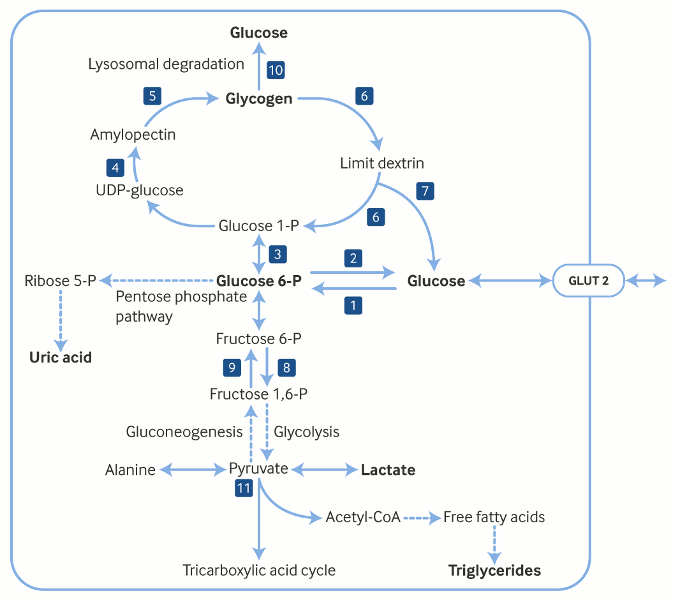Etiology
Glucose-6-phosphate (G6P) is the central metabolite where the major pathways of the endogenous glucose production (i.e., glycogenolysis and gluconeogenesis) come together. The enzyme glucose-6-phosphatase (G6Pase) is encoded by the G6PC1 gene. The transporter protein encoded by the SLC37A4 gene, allows transport of G6P across the endoplasmic reticulum membrane. In the lumen of the endoplasmic reticulum, the G6Pase active site is responsible for the hydrolysis of G6P into glucose and phosphate, the terminal step in glycogenolysis and gluconeogenesis.[4] Biallelic G6PC1 variants are associated with GSD 1a and biallelic SLC37A4 variants are associated with GSD Ib. Over 80 pathogenic variants have been reported in each gene.[4] Importantly, SLC37A4 is also expressed in the neutrophil, while G6PC1 is not.[Figure caption and citation for the preceding image starts]: Simplified scheme of glycogen synthesis and degradation in the liver. Key to scheme: UDP-glucose, uridine diphosphoglucose; 1. hexokinase/glucokinase; 2. glucose 6-phosphatase; 3. phosphoglucomutase; 4. glycogen synthase; 5. branching enzyme; 6. glycogen phosphorylase; 7. debranching enzyme; 8. phosphofructokinase; 9. fructose 1,6-bisphosphatase; 10. acid maltase; 11. pyruvate dehydrogenaseCreated by Dr Joseph I. Wolfsdorf; used with permission [Citation ends].
Key to scheme: UDP-glucose, uridine diphosphoglucose; 1. hexokinase/glucokinase; 2. glucose 6-phosphatase; 3. phosphoglucomutase; 4. glycogen synthase; 5. branching enzyme; 6. glycogen phosphorylase; 7. debranching enzyme; 8. phosphofructokinase; 9. fructose 1,6-bisphosphatase; 10. acid maltase; 11. pyruvate dehydrogenase.
Pathophysiology
GSD I results from lack of activity of the hepatic enzyme complex consisting of glucose-6-phosphate transporter (G6PT) and glucose-6-phosphatase-alpha, which is essential for glycogen breakdown in the liver, kidney, and intestine. Inability to convert glucose-6-phosphate to glucose results in hypoglycemia between meals. Glucose-6-phosphate is shunted into alternative pathways resulting in 3 major metabolic consequences:[4]
Hyperlacticacidemia, which develops as a byproduct of enhanced glycolysis
Hyperuricemia, which arises due to shunting of glucose-6-phosphate into the pentose phosphate pathway
Hypertriglyceridemia, which arises due to both increased production and decreased clearance of triglycerides.
Classification
Glycogen storage disease (GSD) I
Deficient catalytic activity of the glucose-6-phosphatase enzyme system (GSD type Ia)
Deficient transport of glucose-6-phosphate into the endoplasmic reticulum (GSD type Ib)
Use of this content is subject to our disclaimer